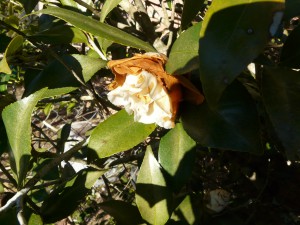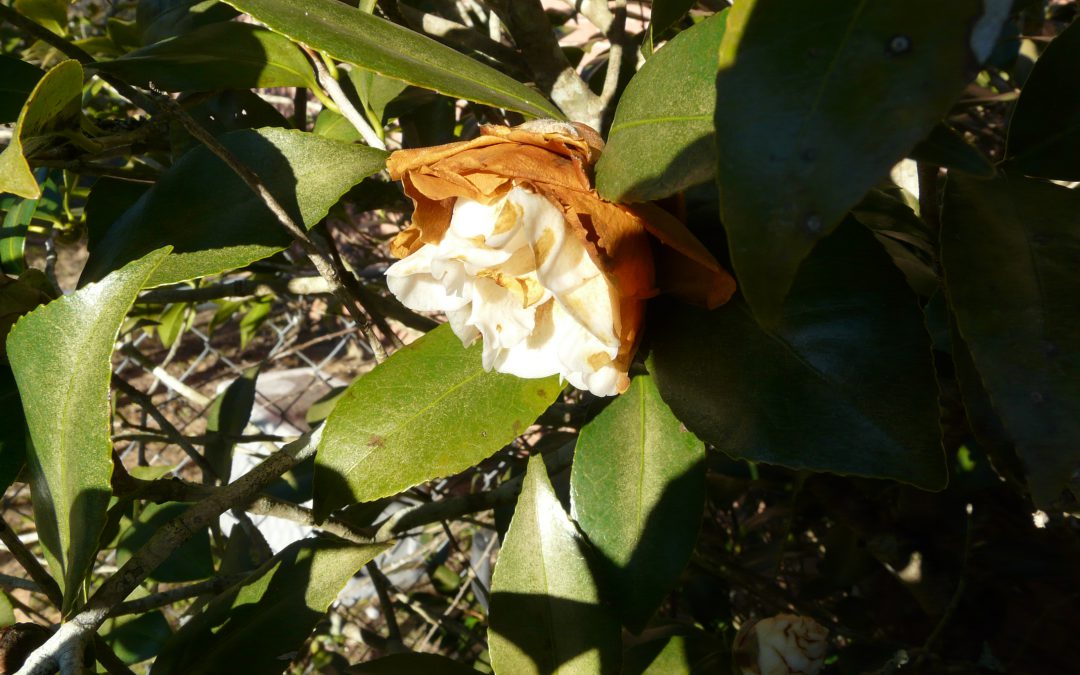
by Larry Williams | Jan 27, 2015
Do you have camellia plants with flower buds that fail to open? Here are possible causes for this problem.
For more information on camellias, contact the UF/IFAS Extension Office in your County or visit http://edis.ifas.ufl.edu/ep002 to access the publication, “Camellias at a Glance.”
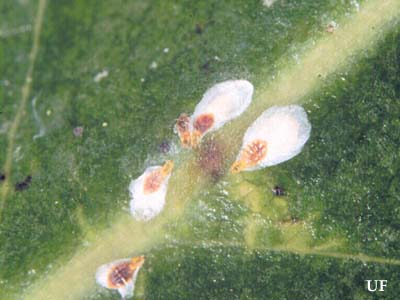
by Matthew Orwat | Jan 27, 2015

The magnolia white scale, Phenacaspis cockerelli, is also called false oleander scale. Image credit http://entomology.ifas.ufl.edu/creatures/orn/scales/false_oleander_scale.htm
Many fruit and ornamental shrubs and trees suffer from scale insects throughout the year. Most of the time home gardeners notice these insects in the spring or summer, because their exudate is the primary substrate for sooty mold growth. Although it seems counter-intuitive, the best time to control scale insects is in late winter. This can be achieved with one or two applications of horticultural oil, often called “dormant oil” in late January and early February.
Horticultural oil has been in use for well over one hundred years. While first only available in dormant oil formulations, it is now available in several types that allow for near year round application. Winter or “dormant” oils are heavier in weight, so they take longer to dissipate. Therefore, they cover pests for longer periods of time and are highly effective. All-season oils are purer, lighter and mixed with an emulsifier. This ensures that it will mix with water well and not damage the plant when exposed to warm, high-light conditions.
Horticultural oils are effective on soft-bodied insects and their eggs. Although scale insects often have a hard outer covering, they are considered soft-bodied. In addition to scale, mealybugs, aphids and spider mites are affected. These oils work primarily by smothering the insect and/or their eggs. Thus when oils are used, they block the insect’s ability to breathe.
Dormant oil is not a cure-all. It does not last very long, therefore the insect must be present for it to work. Additionally, it may kill beneficial insect eggs, so only use when a pest is present and do not apply to areas where infestations are not known. Make sure to cover the underside of the leaves and stems with spray.
Before applying dormant oils read the product label carefully. Any sensitive plants will be listed and temperature limitations will be noted.
Dormant oil is commonly used to control pests on these plants:
- Fruit trees in the Rosaceae (Pear, Apple, Peach, Plum, Nectarine, Blackberry)
- Roses
- Camellia (when not in bloom)
- Magnolia
- Gardenia
- Blueberry
- Crapemyrtle
- Dogwood
- Citrus
- Many others
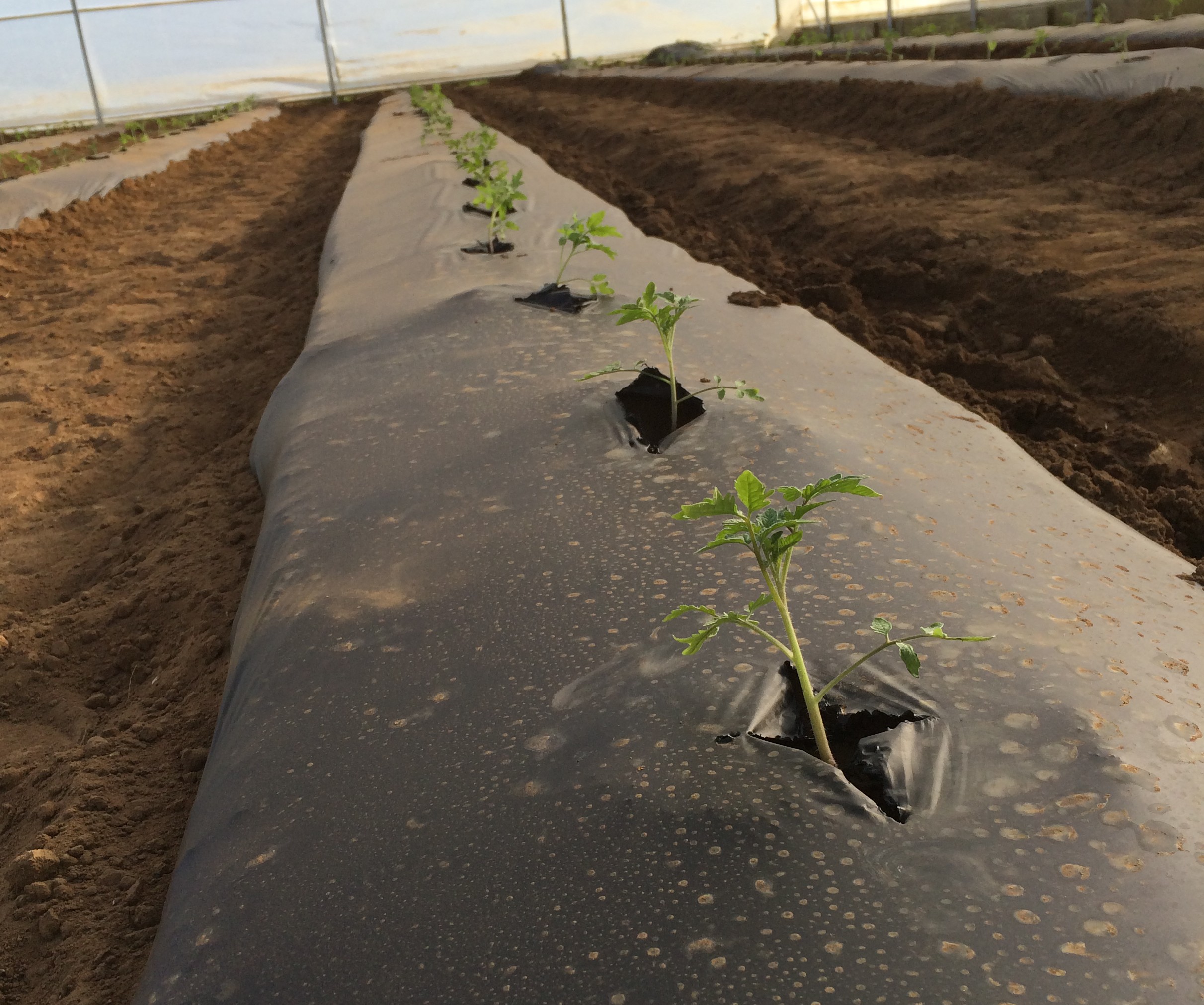
by Blake Thaxton | Jan 27, 2015
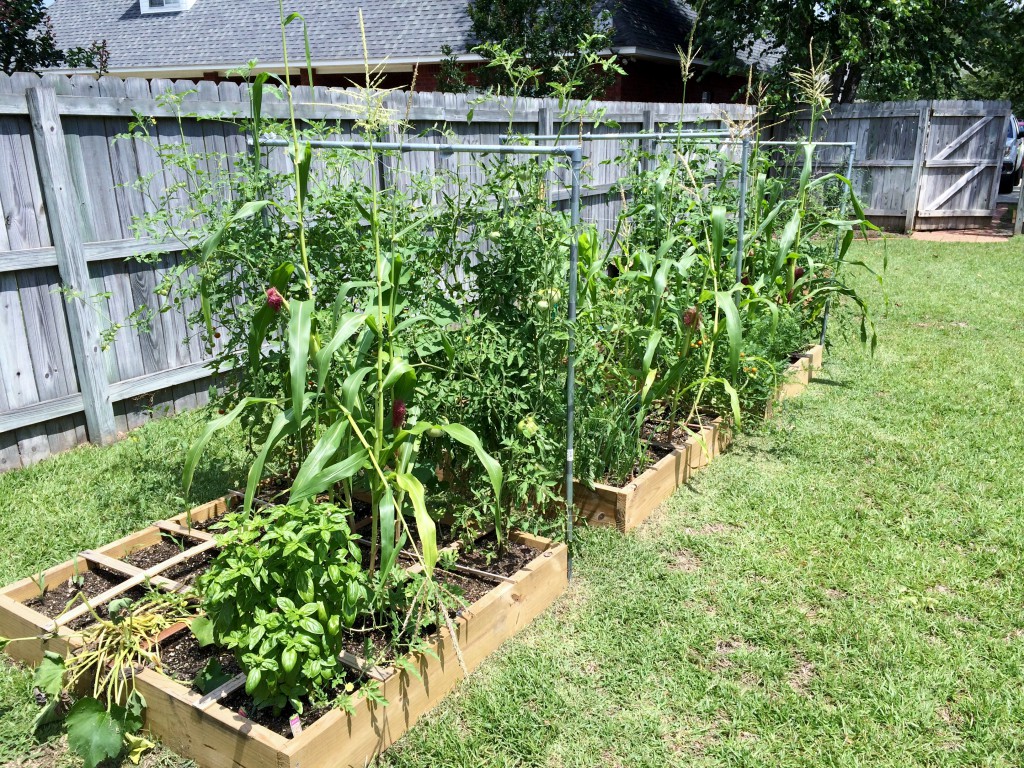
Raised bed spring vegetable garden in NW Florida – photo credit: Blake Thaxton
Growing spring vegetables in northwest Florida can be challenging! Sometimes failures seem more numerous than successes. Extreme cold events in the winter and blistering hot summer days make it tough on vegetables. One suggestion is to get the garden started earlier than usual!
The climate in northwest Florida challenges the gardener due to very high insect pest pressure and it being the perfect environment for fungal and bacterial diseases to grow. Hot and humid summers with moderate winters can be disastrous because diseases will be very active and the insects are not eliminated by extreme cold temperatures. Random cold temperatures in the spring make it hard to know when to plant the vegetable garden.
[important]Because insects and diseases become more active as it gets warmer in the spring, getting a head start may aid the success of your vegetable garden.[/important]
How can a gardener get a head start? Here are a few suggestions:
-
Start Vegetable Transplants Inside
Seems simple, but just getting seed started in a temperature controlled environment can help the vegetable plants get a leg up on the insect pests and diseases that are eminent. If you have a greenhouse structure, that would work perfectly. If not, consider starting your plants in a room with as much possible natural light. On warm days take the plants outside to get some sunshine.
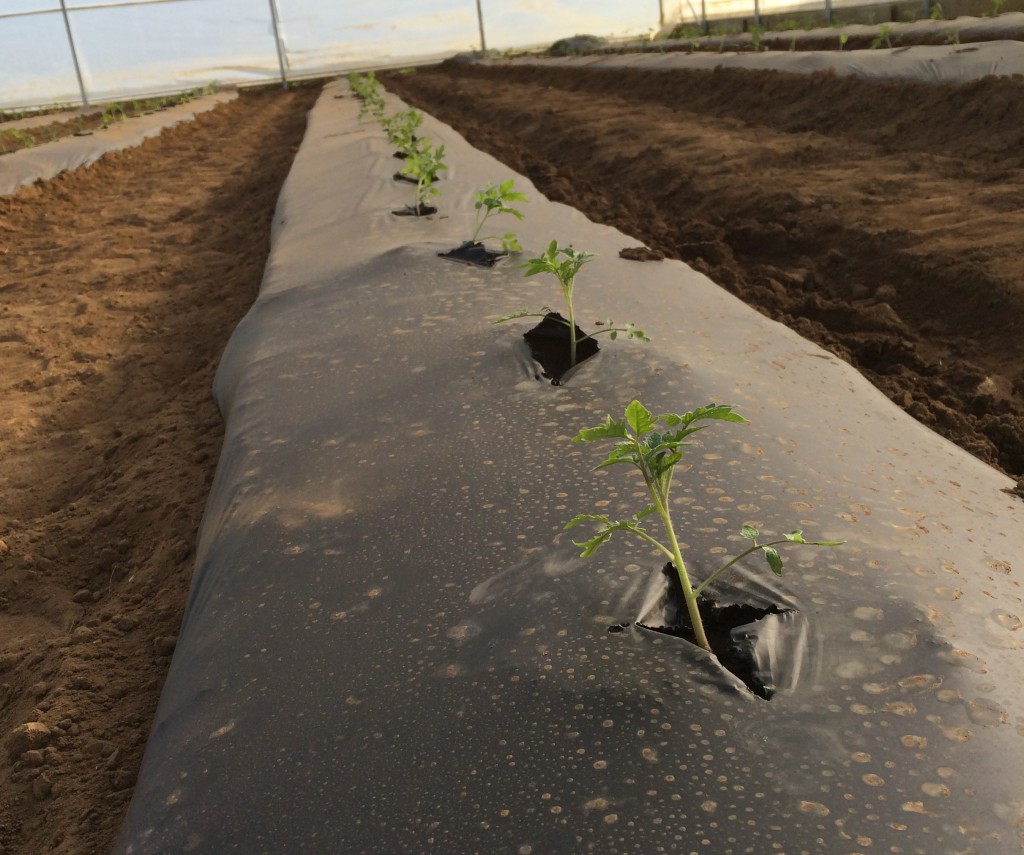
Tomato Plants grown with black plastic mulch – photo credit: Blake Thaxton
Black plastic mulch is commonly used in commercial vegetable production. One of its main functions is to help warm the soil to encourage root growth of the vegetable plants. Other benefits include good moisture and weed control.
Learn more from this Penn State Extension website: Plastic Mulches
Row Covers protect vegetable plants in the ground when temperatures drop lower than expected in the early spring. Row covers are transparent or semitransparent flexible materials used to cover a row of plants to help insulate the air around the plant from the colder temperatures and wind. If you can not find this kind of material you can always use black plastic nursery pots, Styrofoam cups, or other materials to protect individual small plants.
Learn more from this UF/IFAS publication: Row Covers for Growth Enhancement
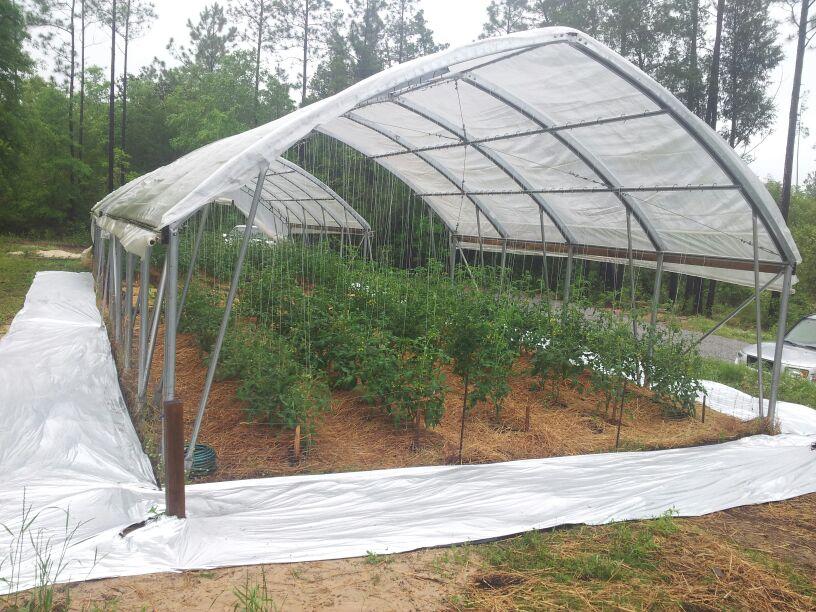
A High Tunnel with end walls and side walls removed for cooling warmer temperatures – photo credit: Blake Thaxton
Another method of protecting your vegetable garden from cold early spring temperatures is to construct a high tunnel, also known as a hoop house. A high tunnel is a structure that looks very much like a greenhouse but the crops are planted in native field soil and the structure lacks an active temperature control. The temperature is passively controlled by rolling up end walls and side walls on warm days and closing the walls when cool temperatures are expected.
Learn how to build a high tunnel from this video from Utah State Extension: How to Build a High Tunnel
For more information on any of these topics please contact your local UF/IFAS Extension Agent or email Blake Thaxton: bthaxton@ufl.edu
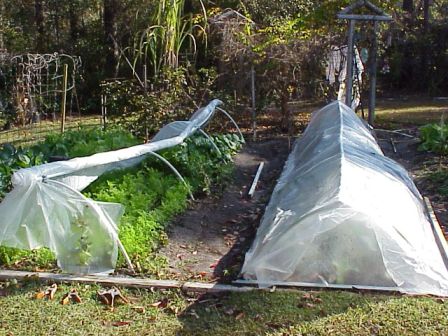
by Eddie Powell | Jan 22, 2015
Florida homeowners enjoy a wide range of landscape and citrus plants and often times desire a tropical or semitropical appearance to their landscapes. Many landscape plants are often planted past their northern limit such as here in Northwest Florida, although microclimates differ dramatically. Tropical and subtropical plants can be used in the landscape, but they must be protected or replaced if necessary during cold weather. A good variety of tender and hardy plants should be planted in order to prevent total devastation of the landscape by extremely cold weather.
The site selection for tender plants should be number one on your list when preparing for a freeze. Tender ornamental plants need a higher site with good air drainage, and not in a low area where cold air settles. Arranging tender plants along fences or other barriers to protect them from cold winds improves the plants’ cold protection, especially from very hard freezes.
Poorly drained soils result in weak shallow roots which are more susceptible to cold injury. Plants grown with the correctly applied rate of nutrients will tolerate colder temperatures better and recover from cold injury faster than plants grown with little or no added nutrients. Be aware that late fall fertilizing of nutrient deficient plants or fertilization before unseasonably warm periods can result in a late growth which is more susceptible to cold injury.
Ornamental plants that are planted under large tree canopies can have more cold protection and require less cold prevention for the owner.
Watering landscape plants before a freeze can help protect plants. A well watered soil will absorb more solar radiation than dry soil and will reradiate heat during the night by as much as 2°F . However, saturated soil conditions can damage the root systems of most plants over a few days, so make sure the ground is well drained.
Avoid late summer or early fall pruning which can alter the plant hormonal balance resulting a flush of new growth. This new growth is more susceptible to cold injury. Healthy plants are more resistant to cold than plants weakened by disease, insect damage, or nematode damage. Routine inspection for pests and implementation of necessary control measures are essential.
Here are a few methods for plant protection. Plants in pots or containers must be moved indoors where heat can be available to them. Containers that have to be left outdoors should be protected by mulches around the container or root ball of plants in the landscape to reduce heat loss from container sidewalls.
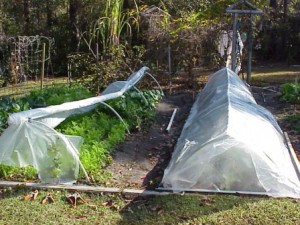
Cold Protection for Veggies!
Coverings can help protect plants more from frost than from extreme cold. Covers that extend to the ground and are not in contact with plant foliage can lessen cold injury to the plant. Foliage in contact with the cover is often cold burned or injured because of heat transfer from the foliage to the colder cover. Some examples of excellent plant covers are cloth sheets, quilts or black plastic. If plastic covering is used, it is extremely important to remove the covering during the day to provide ventilation of trapped heat. A light bulb under a covering also is a simple method of providing heat to ornamental plants in the landscape during the night hours. Cold Damage on Fruit Tree
Cold Damage on Fruit Tree
Pictures By Eddie Powell
Immediately after the frigid weather has passed, plants need to be checked for water loss. The foliage could be losing water vapor or transpiring on a sunny day after a freeze while water in the soil or container medium is frozen. Apply water to thaw the soil and provide available water for the plant. Soils or media with high soluble salts should not be allowed to dry out because salts would be concentrated into a small volume of water and can burn plant roots. Root burn can cause the roots to dry out and not take up water to the plant.
Pruning should be delayed until freezing temperatures have risen or until new growth appears to ensure that live wood is not removed. Dead, unsightly leaves may be removed as soon as they turn brown after a freeze if a high level of maintenance is desired. But it is best to wait until the threat of freezing weather is gone. Cold injury may appear as a lack of spring bud break on a portion or all of the plant, or as an overall weak appearance. Cold injury is usually found in the upper portion of the plant. Branch tips may be damaged while older wood underneath is free of injury. Cold injured wood can be identified by examining the cambium layer under the bark for black or brown coloration. Prune these branches back to a bud 2-3 inches behind the point of discoloration.
For more information on freeze protection of plants see:
Cold Protection of Landscape Plants
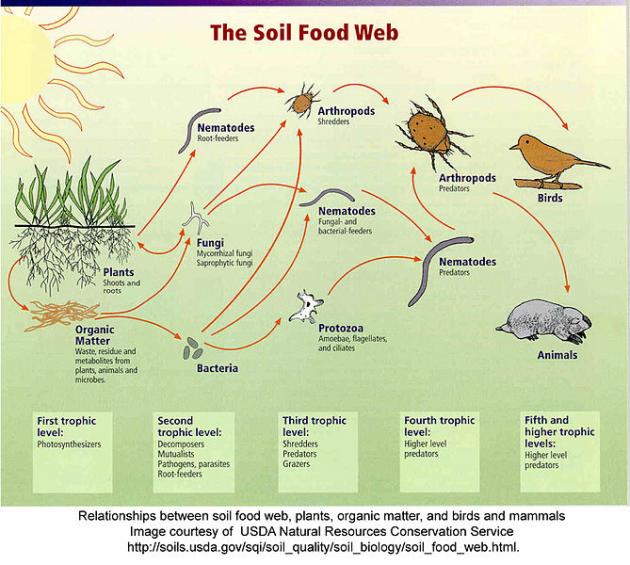
by Taylor Vandiver | Jan 22, 2015
You’re digging up a ridiculously stubborn patch of Florida betony when an earthworm crawls across your path. As you break apart the soil in your hands a world of active organisms is being sifted through your fingers. Fertile soil is teeming with beneficial microbes. It is estimated that there can be billions of microbes in a single gram of soil.
Bacteria, fungi, and protozoa are major players in soil microbial processes. They perform a variety of functions beneficial to soil and the plants growing in that soil. Other soil organisms of importance are nematodes, arthropods, and earthworms.

Soil Food Web. Photo courtesy USDA-NRCS.
Rather than being an inert material, soil houses a dynamic living ecosystem. Most soil organisms are too small to be seen, however they are still performing a great service to gardeners in many ways. These organisms are vitally important to improving the health of our soils. They also play a key role in making nutrients available to plants.
Soil organisms are naturally active during certain times of the year. Most are active during late spring and early summer when the soil is warm and moist. If the soil dries out during the summer months, soil organism activity will decline. During fall months, if there is rain or snow that moistens the soil while it is still warm, soil organisms may resume partial activity. As the soil cools in the fall, many organisms go dormant. It is important for gardeners to note that soil organisms help breakdown certain fertilizers and during the cool, dry months these fertilizers, if applied, will be less available for plants to take up.
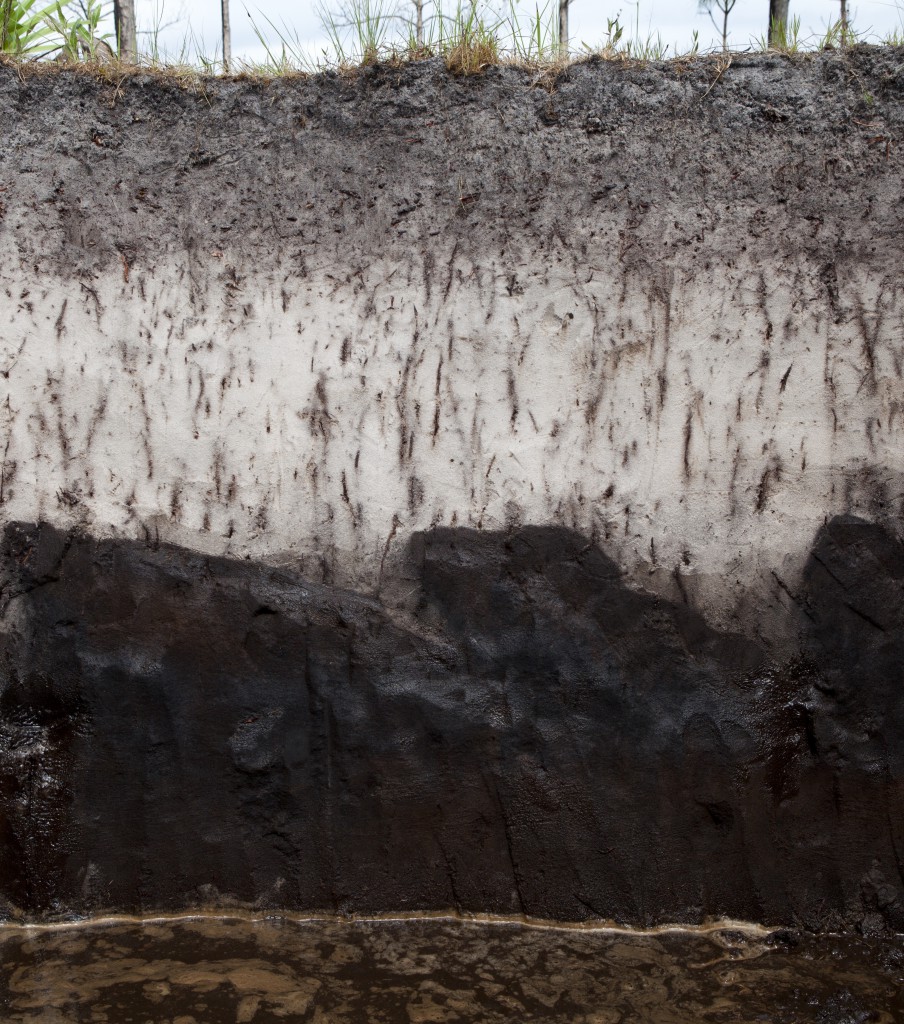
Soil profile. Photo courtesy UF/IFAS.
Soil organisms are generally placed within three categories: organisms that are beneficial to plants, organisms that play a neutral role in plant growth, and organisms that are harmful to plants. Creating a favorable environment for beneficial soil organisms can improve plant growth and reduce garden maintenance. Encouraging their efforts is key to building a healthy fertile soil. Here are some ways you can encourage beneficial organisms in your soil:
- Add organic matter to the soil. Soil organisms require a food source from soil amendments (compost, crop residues) and/or mulch.
- Water effectively. Soil organisms are happiest in an environment that is damp, but not soggy. (Avoid over-irrigation because waterlogged soils will be harmful to beneficial soil organisms)
- Avoid unnecessary tilling, as it can destroy the mycorrhizae and soil structure. Instead of tilling, mulch for weed control.
- Avoid pesticide applications that aren’t necessary. Some fungicides, insecticides and herbicides are harmful to various types of soil organisms.



